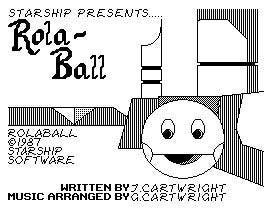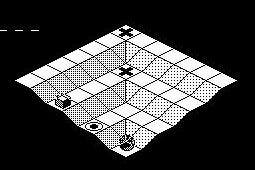Enter the Dragon (32): graph paper, games and growing up
20: GOTO 10.
In the very early days of video game development, most studios designed their graphics and levels on graph paper. At Atari in the 1970s, legendary designers like Ed Logg and Carol Shaw didn't have access to personal computers, instead they sketched out their ideas on paper, then hand coded them into a shared central terminal, line by line. Graph paper is also how Nintendo planned out the Super Mario Bros titles, every section of the landscape drawn on vast maps which were passed between artists and programmers, gathering hand drawn corrections as they went. The iconic Pac-Man maze existed first as a drawing. This is also how I started making and, crucially, thinking about games. But of course, on a much more modest scale.
This was 1987, the very end of the 8bit computer era. I was 15. My family had moved from Cheadle Hulme in Cheshire to Hemel Hempstead, a stark satellite town, drifting off the north western edge of the most distant London suburbs. Apart from my parents and my sisters, I was completely and utterly alone. I was miserable. Arriving too late to enrol in FE college I decided to spend a year working in a bank. It was a terrible decision. All I had was my Commodore 64 and a pretty decent collection of classic titles. Elite, Summer Games, Forbidden Forest, Paradroid. They kept me going.
At the same time, my best friend back in Cheadle Hulme, Jon Cartwright, was starting to teach himself programming. Years before, his dad, who worked in a blood bank, had taken him to work to show him the Commodore PET, an ancient personal computer mostly used in business, but just about affordable. Someone loaded up a version of Duck Hunt and Jon was hooked.
"Like every other kid in the 1980s I wanted a home computer," he recalls. "Every Saturday I'd go into the myriad of stores in Stockport and play with the computers on display. This is back in the day when computers were on sale in Boots, WH Smith, BHS, Dixons, Currys, John Menzies and all. It was inevitable we were going to get one, because on the quiet my Dad was pretty keen too. We ended up getting a Dragon 32 from Boots. My Dad wanted a 'proper keyboard', so that ruled out the much more popular ZX Spectrum. Of course the BBC Micro had a proper keyboard, but it was £399, and the Welsh-made Dragon 32 was only £175."
Jon immediately noticed, of course, that hardly anyone was making games for the Dragon 32. It was a cult machine, not quite as obscure as the Oric Atmos or Jupiter 8, but pretty specialist. So, out of desperation, he taught himself BASIC and started making his own games. Back then, you could buy magazines like Your Computer that came with BASIC listings for simple games, so for 90 pence and a few hours of typing, you had new stuff to play. I was doing this too, first on a ZX81 then a Commodore 64, but I was terrible at maths and just couldn't make that leap from copying listings to actually writing original code. The closest I got was tampering with an early (and terrible) Donkey Kong clone called Krazy Kong, on the C64, which was written entirely in BASIC - you could just hit the run/stop key, then read the program, tweaking values and seeing what happened. Usually nothing good.
But that was then, and this was now. 1987, Hemel Hempstead. My Commodore 64 had broken. I missed Cheadle Hulme, I missed having actual friends. Jon had shown me some of his early Dragon 32 games. He'd started selling them via mail order - you could place little classified ads in the back of early games magazines, and you distributed games on cassettes with photocopied inlays. This is how adventure game creator Charles Cecil started out, packing copies of his first two titles into plastic bags and sending them around the world.
Jon had written a game called Rolaball, which worked like a cross between Marble Madness and the great Ultimate isometric adventures. "By this time I'd taught myself 6809 assembly language so I could write games in machine code which would run so much faster than those written in BASIC," he says. "Of course I'd taught myself from books and experimentation, because there wasn't really anyone I could talk to or ask for advice at the time. I'm sure my code was awful, but for the most part it worked."
It sold well - well enough for him to buy a proper Dragon monitor and a floppy disc drive; well enough to think about a more ambitious sequel. This is where I came in. Jon just wanted to code, he didn't want to design the levels, but I had a lot of time on my hands, and was going crazy working in the machine room at a bank. I said I'd help. In the game, the ball had to negotiate a series of rooms filled with obstacles and enemies - it was all flip-screen, no scrolling, because that was beyond our technical acumen. So I bought a load of graph paper and started sketching out plans.
What you learn straightaway is that when designing games on paper you're missing two important attributes: depth and time. When I drew a level I had to picture it as an isometric display, where every object had a height value, and every square represented not only the distance between two objects, but also the time it would take to traverse that distance. I'd post levels to Jon and they'd come back a few days later with crossings-out and corrections, because the enemies moved in a different way than I imagined. I was spending most of my earnings on paper and stamps. I'd also bought my own Dragon 32 via the classified listings in Micro Mart. It was £32 and came with two lovely analogue joysticks. I was playing the original Rolaball so I could get a handle on how things worked.

The important thing was, with every graph we sent to each other, we were also writing about our lives, catching up, chatting. For us, designing video games became a kind of epistolary venture - we were communicating through the act of making something. It was like working together on a Minecraft building, but massively slowed down.
When the game was finished, we took it to trade fairs to sell. "Because the Dragon wasn't the most popular computer there weren't any big computer shows in London like there were for other computers," says Jon. "Instead they were in glamorous locations like Ossett Town Hall. And I exhibited at a bunch of them. By this time I had other people selling my games and paying me royalties so I was showing off new games or coming soon stuff."
It was amazing fun. We met these weird characters on the periphery of the eighties games business; old guys selling joysticks, exotic disc drives and dot matrix printers on trestle tables in places that would usually host craft fairs or WI meetings. Jon's publisher at the time would turn up with a car boot full of games to sell, then wander around signing new titles. I started writing for a little Dragon 32 fanzine, having met the editor at one of these events. The first game I reviewed was called Gis A Job, which took the bleak Alan Bleasdale TV series Boys from the Black Stuff and transformed it into a platform game where you just had to headbutt enemies. Think of a cross between a Ken Loach film and Bubble Bobble and you're practically there.
After Rolaball 2, we worked on another game called Impossiball, inspired by the Gremlin Graphics title Trailblazer. By this time it was 1990, and the Dragon scene was dying. Jon bought an Atari ST and we started playing about with an idea for a scrolling platform adventure - sort of Castlevania-esque - but you controlled two characters simultaneously; or it may have been one character split between two quantum dimensions. Anyway, it was ridiculously ambitious and complicated and by then Jon had started a degree at Lancaster University. "I discovered beer and girls," he laments.

I will never forget those days. I will never forget Jon's kindness, making me feel useful on his games, taking me to those trade fairs, helping me make connections and start thinking of video games in a different way. That was the real value of those old graphs. I started to understand game design in a very different way; I understood the principles structure and space, and this in turn informed my writing. I learned how to deconstruct single moments of gameplay, I learned how to describe pixels.
By some coincidence, in 1992, Jon got a job at Big Red Software in Leamington, just as I moved there for my second year at Warwick University. He was working on the Dizzy games, I was studying Shakespeare. But we just took up where we left off. Eventually, I got a job at Big Red too - doing what I'd always done in game development - just enough to seem useful.
While I was writing this little article, I emailed Jon to get his side of the story. By the way, he stayed in the industry, worked on some big games, then moved to Australia where he's consulting on an interesting new RPG; we've always been in touch. Anyway, he ended his reply to me with a thought that I'm going to share here.
"And whilst I know you and I had kept in touch all that time, and even visited each other, it was a pleasant surprise that you'd decided to go to Uni in Warwick just down the road from where I was. I still remember appearing on campus unannounced to see you. I wonder if we'd both be doing the same things now if that hadn't all happened?"
I spent two years in PC game development and 20 years in games writing - how much of that do I owe to Jon and the little games we made together? Did my love of video games come from the years I spent playing Commodore 64 titles, or from my brief career as a Dragon 32 developer? How much of what happens in our lives is constructed in fragile moments of luck and friendship? I just know that helping to make Rolaball 2 got me through a tough couple of years. And, Jon, the answer is I don't know. I don't know where we'd be if all that hadn't happened. Jon, my old friend, I don't want to know.










